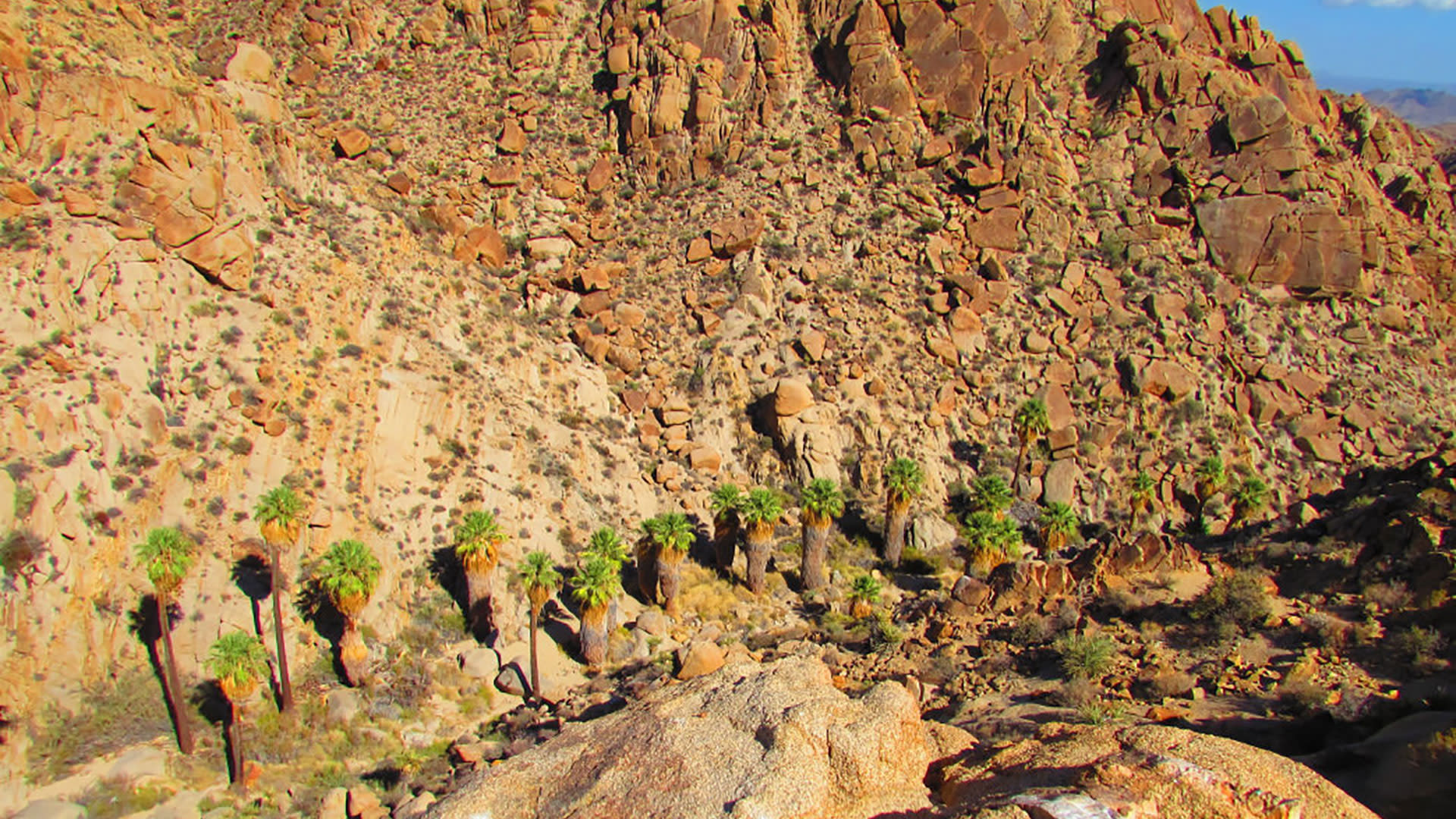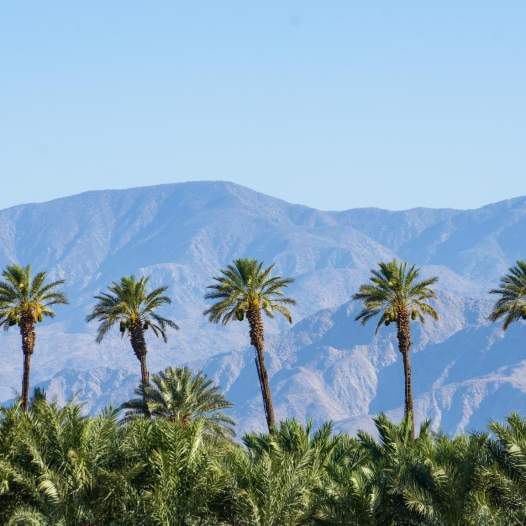The Greater Palm Springs area is filled with hiking opportunities that allow you to explore incredible oases among the desert landscapes. Some are quick and easy trips to view the splendor, while others are strenuous treks not to be taken lightly. But all of them offer a rewarding experience that leads to these truly inspiring natural sites. Here are some of our favorites. Visit Hiking in GPS for even more hikes and information.

The Indian Canyons, Palm Springs
Mileage: 0.5 - 7 miles round trip
Difficulty: Easy to strenuous
Best time to go: Fall, winter, spring
For a small entrance fee, one can explore the world-famous Indian Canyons situated on the Agua Caliente Indian Reservation. These canyons are blessed with an unusually high concentration of natural springs that support several groves of California fan palms, including the well-known Palm Canyon Oasis. To reach Palm Canyon, simply drive about 2 miles beyond the toll booth to the end of the road and park at the Trading Post. A short yet steep walk into the canyon greets you with one of the largest palm oases known.
For an easy 2-mile round trip hike, park at the Andreas Canyon trailhead and enjoy a relaxing walk weaving through the palms and past serene pools and ancient bedrock mortars. For a heart-pumping yet historical hike, try the Maynard Mine Trail, which is a 10-mile round trip with 2,000 feet in elevation gain. During World War II, this mine processed tungsten to support the nation’s desperate need for metal ores.
Bear Creek Canyon, La Quinta
Mileage: 16.6 miles round trip, ~2,300 feet elevation gain
Difficulty: Strenuous
Best time to go: Fall, winter, spring
For those seeking a longer journey to an oasis, the Bear Creek Canyon Trail provides a long, heart-pumping hike with spectacular glimpses of Greater Palm Springs below and the high country above. While many other oases in the valley are right off the road, and consequently are jam-packed during the weekends, this palm oasis weeds out much of the sightseeing crowd and leaves you in solitude for the most part.
Due to its remoteness, you may be rewarded with a bighorn sheep sighting if you keep your eyes peeled. It can be tricky if you don’t watch for the trail to the oasis as it actually hops out of the wash into a side canyon.

Big Morongo Canyon Preserve
Mileage: 0.6 - 8.34 miles roundtrip
Difficulty: Easy to moderate
Best time to go: Fall, winter, spring
Although palm trees come to mind when one thinks of an oasis, that’s not always the case. At Big Morongo Canyon Preserve, you can seek the shade of cottonwoods, willows, sycamores, alders, mesquite, and a few palms.
The variety of trees isn’t the only attraction though. A birder’s paradise, the marsh within the preserve supports the second-highest density of breeding birds known in the United States. Many come to scope out the rare bird species that migrate through like the vermillion flycatcher and least bell’s vireo.
Whether you do the short 0.6-mile roundtrip Marsh Trail or combine all the loops together, you’ll be surprised how much water truly exists under the shade. Come the spring, the Pacific Tree Frog leaves its winter hibernation beneath the ground and migrates into the lush marsh and its slow-moving water, where the males croak a shockingly loud chorus to attract a mate.

Oasis of Mara, Twentynine Palms
Mileage: 0.5 mile roundtrip
Difficulty: Easy
Best time to go: Fall, winter, spring
Just behind the Joshua Tree National Park visitor center in Twentynine Palms, the Oasis of Mara offers a quick stretch of the legs (as you journey to your next desert destination) with its paved ADA-accessible pathway. The first tribe recorded to live here, the Serrano, dubbed it Mah-rah meaning “the place of little springs and much grass.” Although the oasis has seen better days (the springs were practically drained dry when the town of Twentynine Palms began to grow), one can still imagine the Serrano, and later the Chemehuevi, sustaining themselves all year on the life-giving springs. Today, the little oasis is a bustle of animal activity especially for the early birds, both human and avian.

Cottonwood Springs
Mileage: Just past the parking lot
Difficulty: Easy
Best time to go: Fall, winter, spring
If traveling through the entirety of Joshua Tree National Park, consider a shady break from the dusty trail at Cottonwood Spring. Here, cottonwood trees intermingle with California fan palms to make for a most ambient green light to sit under and listen to the birds scurry about in the shadows. As you do so, imagine yourself sitting in this shade with the Cahuilla who lived at the spring for hundreds of years leaving behind bedrock mortars that feel powder-smooth to your fingertips. Or even imagine the grinding sound of the arrastra (a circular drag-stone mill for crushing ore) that resides below the spring dating back to the gold mining days.

Lost Palms Oasis
Mileage: 7.5 miles roundtrip, ~375 feet elevation gain
Difficulty: Moderately strenuous
Best time to go: Fall, winter, spring
Lost Palm Oasis lives up to its name as it is A) located in the lesser-known part of Joshua Tree National Park and B) can be somewhat tricky to know when you have arrived. You traverse some classic Colorado Desert terrain, walking over what seems like an endless number of rolling granite hills and diving down into sandy washes. On warmer days, lizards like the zebra-tail dart past you with almost every footstep. For a plant enthusiast, the variety of species is exceptional (junipers and ocotillos commingling!) for being the “desolate part” of the park.
But the real fun is in the not knowing—you walk and you walk and you walk, and then boom! A sign saying “Lost Palms Oasis” pops out of nowhere and there you are, peering down into the Oasis Canyon from above. As you scan the landscape with a keen eye, several smaller palm groves pop into view in the nooks and crannies of the canyon. For the more adventurous type, find a navigable slope to take you down to the palms, and if you really have enough energy, head down-canyon for a half-mile to the Victory Palm Oasis.




















